Mark Purcell
MAD-MAX: Modular And Diverse Malicious Attack MiXtures for Automated LLM Red Teaming
Mar 08, 2025Abstract:With LLM usage rapidly increasing, their vulnerability to jailbreaks that create harmful outputs are a major security risk. As new jailbreaking strategies emerge and models are changed by fine-tuning, continuous testing for security vulnerabilities is necessary. Existing Red Teaming methods fall short in cost efficiency, attack success rate, attack diversity, or extensibility as new attack types emerge. We address these challenges with Modular And Diverse Malicious Attack MiXtures (MAD-MAX) for Automated LLM Red Teaming. MAD-MAX uses automatic assignment of attack strategies into relevant attack clusters, chooses the most relevant clusters for a malicious goal, and then combines strategies from the selected clusters to achieve diverse novel attacks with high attack success rates. MAD-MAX further merges promising attacks together at each iteration of Red Teaming to boost performance and introduces a similarity filter to prune out similar attacks for increased cost efficiency. The MAD-MAX approach is designed to be easily extensible with newly discovered attack strategies and outperforms the prominent Red Teaming method Tree of Attacks with Pruning (TAP) significantly in terms of Attack Success Rate (ASR) and queries needed to achieve jailbreaks. MAD-MAX jailbreaks 97% of malicious goals in our benchmarks on GPT-4o and Gemini-Pro compared to TAP with 66%. MAD-MAX does so with only 10.9 average queries to the target LLM compared to TAP with 23.3. WARNING: This paper contains contents which are offensive in nature.
Adversarial Prompt Evaluation: Systematic Benchmarking of Guardrails Against Prompt Input Attacks on LLMs
Feb 21, 2025Abstract:As large language models (LLMs) become integrated into everyday applications, ensuring their robustness and security is increasingly critical. In particular, LLMs can be manipulated into unsafe behaviour by prompts known as jailbreaks. The variety of jailbreak styles is growing, necessitating the use of external defences known as guardrails. While many jailbreak defences have been proposed, not all defences are able to handle new out-of-distribution attacks due to the narrow segment of jailbreaks used to align them. Moreover, the lack of systematisation around defences has created significant gaps in their practical application. In this work, we perform systematic benchmarking across 15 different defences, considering a broad swathe of malicious and benign datasets. We find that there is significant performance variation depending on the style of jailbreak a defence is subject to. Additionally, we show that based on current datasets available for evaluation, simple baselines can display competitive out-of-distribution performance compared to many state-of-the-art defences. Code is available at https://github.com/IBM/Adversarial-Prompt-Evaluation.
Granite Guardian
Dec 10, 2024



Abstract:We introduce the Granite Guardian models, a suite of safeguards designed to provide risk detection for prompts and responses, enabling safe and responsible use in combination with any large language model (LLM). These models offer comprehensive coverage across multiple risk dimensions, including social bias, profanity, violence, sexual content, unethical behavior, jailbreaking, and hallucination-related risks such as context relevance, groundedness, and answer relevance for retrieval-augmented generation (RAG). Trained on a unique dataset combining human annotations from diverse sources and synthetic data, Granite Guardian models address risks typically overlooked by traditional risk detection models, such as jailbreaks and RAG-specific issues. With AUC scores of 0.871 and 0.854 on harmful content and RAG-hallucination-related benchmarks respectively, Granite Guardian is the most generalizable and competitive model available in the space. Released as open-source, Granite Guardian aims to promote responsible AI development across the community. https://github.com/ibm-granite/granite-guardian
Towards Assurance of LLM Adversarial Robustness using Ontology-Driven Argumentation
Oct 10, 2024



Abstract:Despite the impressive adaptability of large language models (LLMs), challenges remain in ensuring their security, transparency, and interpretability. Given their susceptibility to adversarial attacks, LLMs need to be defended with an evolving combination of adversarial training and guardrails. However, managing the implicit and heterogeneous knowledge for continuously assuring robustness is difficult. We introduce a novel approach for assurance of the adversarial robustness of LLMs based on formal argumentation. Using ontologies for formalization, we structure state-of-the-art attacks and defenses, facilitating the creation of a human-readable assurance case, and a machine-readable representation. We demonstrate its application with examples in English language and code translation tasks, and provide implications for theory and practice, by targeting engineers, data scientists, users, and auditors.
Developing Assurance Cases for Adversarial Robustness and Regulatory Compliance in LLMs
Oct 04, 2024


Abstract:This paper presents an approach to developing assurance cases for adversarial robustness and regulatory compliance in large language models (LLMs). Focusing on both natural and code language tasks, we explore the vulnerabilities these models face, including adversarial attacks based on jailbreaking, heuristics, and randomization. We propose a layered framework incorporating guardrails at various stages of LLM deployment, aimed at mitigating these attacks and ensuring compliance with the EU AI Act. Our approach includes a meta-layer for dynamic risk management and reasoning, crucial for addressing the evolving nature of LLM vulnerabilities. We illustrate our method with two exemplary assurance cases, highlighting how different contexts demand tailored strategies to ensure robust and compliant AI systems.
Knowledge-Augmented Reasoning for EUAIA Compliance and Adversarial Robustness of LLMs
Oct 04, 2024



Abstract:The EU AI Act (EUAIA) introduces requirements for AI systems which intersect with the processes required to establish adversarial robustness. However, given the ambiguous language of regulation and the dynamicity of adversarial attacks, developers of systems with highly complex models such as LLMs may find their effort to be duplicated without the assurance of having achieved either compliance or robustness. This paper presents a functional architecture that focuses on bridging the two properties, by introducing components with clear reference to their source. Taking the detection layer recommended by the literature, and the reporting layer required by the law, we aim to support developers and auditors with a reasoning layer based on knowledge augmentation (rules, assurance cases, contextual mappings). Our findings demonstrate a novel direction for ensuring LLMs deployed in the EU are both compliant and adversarially robust, which underpin trustworthiness.
Towards Assuring EU AI Act Compliance and Adversarial Robustness of LLMs
Oct 04, 2024


Abstract:Large language models are prone to misuse and vulnerable to security threats, raising significant safety and security concerns. The European Union's Artificial Intelligence Act seeks to enforce AI robustness in certain contexts, but faces implementation challenges due to the lack of standards, complexity of LLMs and emerging security vulnerabilities. Our research introduces a framework using ontologies, assurance cases, and factsheets to support engineers and stakeholders in understanding and documenting AI system compliance and security regarding adversarial robustness. This approach aims to ensure that LLMs adhere to regulatory standards and are equipped to counter potential threats.
MoJE: Mixture of Jailbreak Experts, Naive Tabular Classifiers as Guard for Prompt Attacks
Sep 27, 2024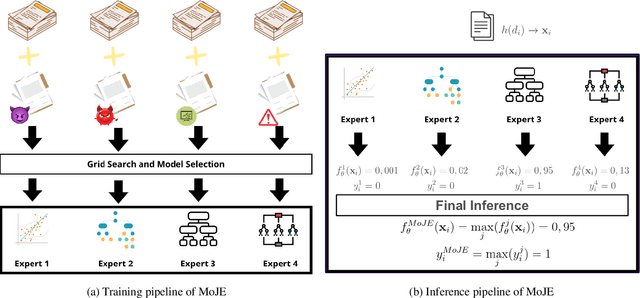
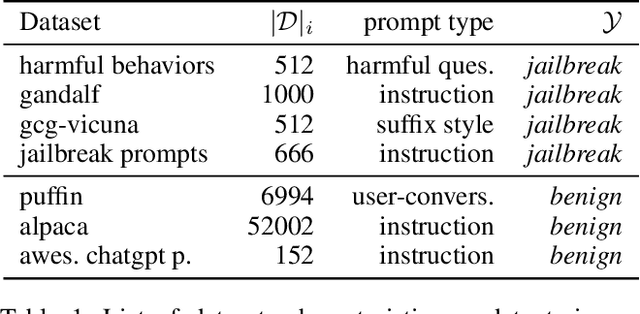
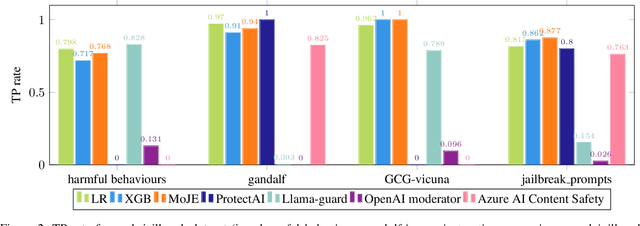
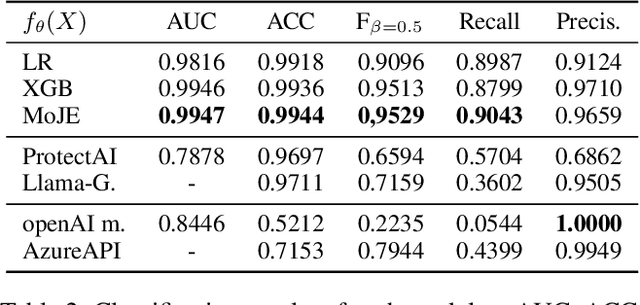
Abstract:The proliferation of Large Language Models (LLMs) in diverse applications underscores the pressing need for robust security measures to thwart potential jailbreak attacks. These attacks exploit vulnerabilities within LLMs, endanger data integrity and user privacy. Guardrails serve as crucial protective mechanisms against such threats, but existing models often fall short in terms of both detection accuracy, and computational efficiency. This paper advocates for the significance of jailbreak attack prevention on LLMs, and emphasises the role of input guardrails in safeguarding these models. We introduce MoJE (Mixture of Jailbreak Expert), a novel guardrail architecture designed to surpass current limitations in existing state-of-the-art guardrails. By employing simple linguistic statistical techniques, MoJE excels in detecting jailbreak attacks while maintaining minimal computational overhead during model inference. Through rigorous experimentation, MoJE demonstrates superior performance capable of detecting 90% of the attacks without compromising benign prompts, enhancing LLMs security against jailbreak attacks.
Privacy-Preserving Federated Learning over Vertically and Horizontally Partitioned Data for Financial Anomaly Detection
Oct 30, 2023Abstract:The effective detection of evidence of financial anomalies requires collaboration among multiple entities who own a diverse set of data, such as a payment network system (PNS) and its partner banks. Trust among these financial institutions is limited by regulation and competition. Federated learning (FL) enables entities to collaboratively train a model when data is either vertically or horizontally partitioned across the entities. However, in real-world financial anomaly detection scenarios, the data is partitioned both vertically and horizontally and hence it is not possible to use existing FL approaches in a plug-and-play manner. Our novel solution, PV4FAD, combines fully homomorphic encryption (HE), secure multi-party computation (SMPC), differential privacy (DP), and randomization techniques to balance privacy and accuracy during training and to prevent inference threats at model deployment time. Our solution provides input privacy through HE and SMPC, and output privacy against inference time attacks through DP. Specifically, we show that, in the honest-but-curious threat model, banks do not learn any sensitive features about PNS transactions, and the PNS does not learn any information about the banks' dataset but only learns prediction labels. We also develop and analyze a DP mechanism to protect output privacy during inference. Our solution generates high-utility models by significantly reducing the per-bank noise level while satisfying distributed DP. To ensure high accuracy, our approach produces an ensemble model, in particular, a random forest. This enables us to take advantage of the well-known properties of ensembles to reduce variance and increase accuracy. Our solution won second prize in the first phase of the U.S. Privacy Enhancing Technologies (PETs) Prize Challenge.
Towards an Accountable and Reproducible Federated Learning: A FactSheets Approach
Feb 25, 2022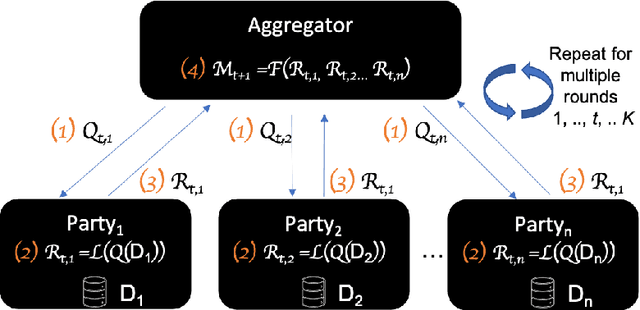
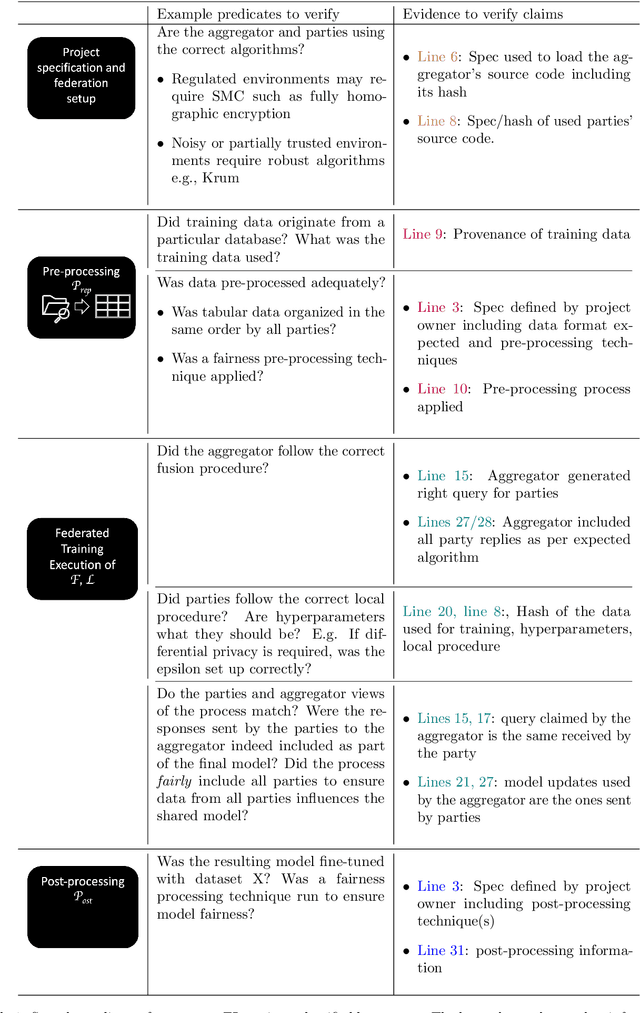
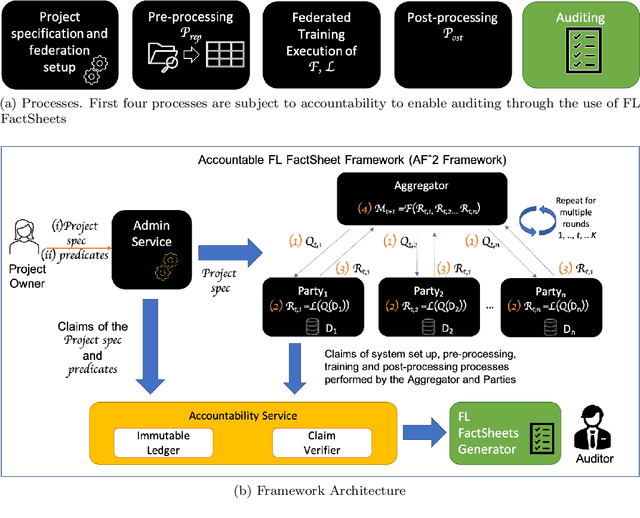
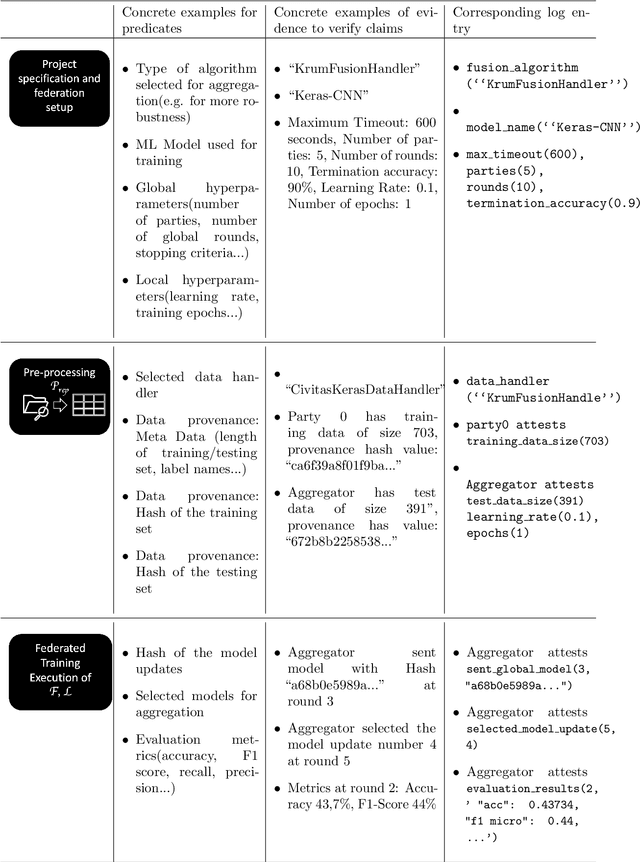
Abstract:Federated Learning (FL) is a novel paradigm for the shared training of models based on decentralized and private data. With respect to ethical guidelines, FL is promising regarding privacy, but needs to excel vis-\`a-vis transparency and trustworthiness. In particular, FL has to address the accountability of the parties involved and their adherence to rules, law and principles. We introduce AF^2 Framework, where we instrument FL with accountability by fusing verifiable claims with tamper-evident facts, into reproducible arguments. We build on AI FactSheets for instilling transparency and trustworthiness into the AI lifecycle and expand it to incorporate dynamic and nested facts, as well as complex model compositions in FL. Based on our approach, an auditor can validate, reproduce and certify a FL process. This can be directly applied in practice to address the challenges of AI engineering and ethics.
 Add to Chrome
Add to Chrome Add to Firefox
Add to Firefox Add to Edge
Add to Edge